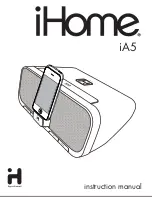
ICAM by Xtralis
IAS-2 Product Guide
www.xtralis.com
13
5
Pipe Installation
This section provides a simple guide to pipe installation and should contain all the information required for
simple installations based on the standard configurations shown in Section 5.8:
More information on achieving an ActivFire compliant pipe installation can be found in Section 9:
Use appropriate CPVC/ABS pipe with sampling point holes drilled along its length. The pipe run is terminated
with an end cap that has a hole drilled in its center.
The position of each individual sampling point should be in accordance with the rules for the positioning of
point detectors. It is important to note that the concentration of smoke on an individual sample point will be
diluted by the clean air from the other sample points and the end cap hole.
5.1
Pipe Specification
For AS 1603.8 compliance, the pipe shall have equal mechanical strength to light duty AS 2053 compliant
PVC conduit. The pipe shall be red, or have a longitudinal red mark at least 2 mm wide along the whole length
of the pipe. The pipe shall be marked with descriptions such as "FIRE DETECTION SYSTEM - DO NOT
PAINT" in letters at least 5 mm high, at intervals of 1 m or less.
Note:
The IAS-2 inlet ports are tapered to allow a push fit of the sampling pipe. The pipes should be cut
squarely to ensure a good, airtight seal. Solvent adhesive should not be used for this joint.
5.2
Fixings
The normal fixing methods are pipe clips, saddle clamps or even tie wraps. Fixing centers are typically 1.5 m
(4.9 ft) apart.
5.3
Holes
The sampling pipe is perforated with sampling holes and can either be pre-drilled or drilled in situ. Care should
be taken to avoid swarf entering the pipe. Always blow compressed air through the pipe after drilling to clear
any debris before final connection to the equipment. In standard configuration, with pipe hanging from ceiling,
the holes should be placed underneath, so the smoke can easily rise up into the hole.
5.4
End Cap
Figure 5-1: End cap with hole drilled in center
The end of the pipe must be capped with an end cap and not be left open. The end cap typically has a
sampling hole drilled in its center to control airflow. For pipes with only a few sampling holes, the end cap hole
usually is the same size as the sampling holes along the pipe. See Section 5.8:
for
approved configurations.
Summary of Contents for ICAM IAS-2
Page 1: ...Xtralis ICAM IAS 2 Product Guide July 2010 Document Number 14942_05 Part Number 29301 ...
Page 2: ......
Page 6: ...IAS 2 Product Guide ICAM by Xtralis iv www xtralis com This page is intentionally left blank ...
Page 8: ...IAS 2 Product Guide ICAM by Xtralis 2 www xtralis com This page is intentionally left blank ...
Page 10: ...IAS 2 Product Guide ICAM by Xtralis 4 www xtralis com This page is intentionally left blank ...
Page 12: ...IAS 2 Product Guide ICAM by Xtralis 6 www xtralis com This page is intentionally left blank ...
Page 18: ...IAS 2 Product Guide ICAM by Xtralis 12 www xtralis com This page is intentionally left blank ...
Page 22: ...IAS 2 Product Guide ICAM by Xtralis 16 www xtralis com This page is intentionally left blank ...
Page 28: ...IAS 2 Product Guide ICAM by Xtralis 22 www xtralis com This page is intentionally left blank ...
Page 30: ...IAS 2 Product Guide ICAM by Xtralis 24 www xtralis com This page is intentionally left blank ...
Page 32: ...IAS 2 Product Guide ICAM by Xtralis 26 www xtralis com This page is intentionally left blank ...
Page 36: ...IAS 2 Product Guide ICAM by Xtralis 30 www xtralis com This page is intentionally left blank ...
Page 38: ...IAS 2 Product Guide ICAM by Xtralis 32 www xtralis com This page is intentionally left blank ...
















































